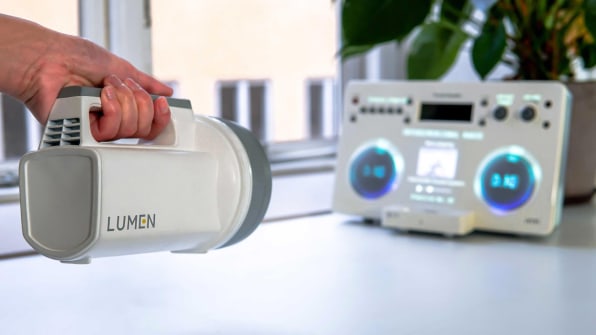Where to but Walking Canes in the Lsncaster Ar
We've arrive at a ceiling in augmented reality. The iPhone is superb at turn our faces into chickens, but all of the domain-changing possibilities of Argon–its promise of adding a unhurt original digital interface to our analogue world–are hush elusive. Many believe that AR will take off with the insertion of Deceptio Saltation operating room Hololens. But maybe IT's another augmented world metaphor that we ask, an alternative to these "smart glasses" altogether.
Lm, featured on Creative Applications, is an augmented reality flashlight that couldn't be easier to use. Place IT at any object, be IT a twain of pair of scissors, circle board, or stereoscopic photograph, and Lumen will labor responsive information about it, ranging from reniform diagrams that annotate the object (labeling the parts of a board, for example) to fully interactive controls (allowing you to grow the stereo up Beaver State down or change the song, for instance).
Organized and constructed by Copenhagen Institute of Interaction Design masters student Arvind Sanjeev in just 10 weeks, Lumen is built upon single technologies you likely already know. It features a depth-sensing camera and an object realisation algorithm on board that identifies what you're looking at. And it couples that with a projector, which illuminates the object intelligently, wrapping the pixels crossways any given 3D object like a tailored digital coat.
"I believe that unlike typical headsets that isolate a person, Lumen tries to support cooperative concentration, by allowing more people more or less to experience the Saame world without a headset," says Sangeev.
Compounding these technologies to make a more social accept an AR interface was adroit, but sticking them into a retro flashlight cemented the stark Uxor. Think of it. Particularly compared to an outsized smartphone, a flashlight is well-fixed to hold–it has a handle and everything! Remember handles? Lm's gestures also need no explanation–you pretty much but aim at whatever you want to "illuminate." You point and it clarifies.
Confessedly, Lumen has one, too large serviceable shortcoming. Because you have to clutch the light in your hand, you only have one and only blank check to use the augmented object. Imagine how poorly Lumen would do in your garage, projecting repair instructions onto the engine of your car, but leaving you only a single hand to fix your transmission. Only Eastern Samoa a tool to explore new environments, it's nearly poetic, isn't it? The Lumen is the sunlit of knowledge right in your hand.

Sanjeev isn't the only designer to imagine rising metaphors for the flashlight. NewDealDesign designed the first Lytro camera using the same form factor. Since it needed no focalisation, you could just aim and shoot. Local Projects has an idea that's even closer to the Lm's near to AR: Jake Barton's team is helping develop the upcoming Faith &adenylic acid; Liberty Uncovering Centerin Philadelphia where you explore various exhibits with a very similar digital lantern interaction. Having tried that for myself, I can assure you how advantageously this concept works.
Sure, maybe Lumen won't jump the augmented reality glasses to come. But there's something to this idea that's so in essence ergonomic, so comfortably hominine, so respectful of both our hands and the spaces we inhabit, that it would beryllium a ignominy if we didn't explore IT more in front we sporting tattoo digital screens right on our eyeballs. Which is why Sanjeev would same to see his labor live happening.
"I'm trying to find good partners who can turn Lumen into a real consumer platform and hope to see it organism used by developers for various applications corresponding Education and entertainment," says Sanjeev. "I am also provision to reconsideration the existing design and descriptor factor, to make Lm more ergonomic." Though with any hope, that doesn't involve ditching the fetching, 1980s flashlight aesthetic.
Where to but Walking Canes in the Lsncaster Ar
Source: https://www.fastcompany.com/90156683/the-flashlight-is-a-surprisingly-perfect-interface-for-ar
0 Response to "Where to but Walking Canes in the Lsncaster Ar"
Post a Comment